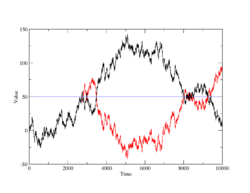Reflection principle (Wiener process)

In the theory of probability for stochastic processes, the reflection principle for a Wiener process states that if the path of a Wiener process f(t) reaches a value f(s) = a at time t = s, then the subsequent path after time s has the same distribution as the reflection of the subsequent path about the value a.[1] More formally, the reflection principle refers to a lemma concerning the distribution of the supremum of the Wiener process, or Brownian motion. The result relates the distribution of the supremum of Brownian motion up to time t to the distribution of the process at time t. It is a corollary of the strong Markov property of Brownian motion.
Statement
If [math]\displaystyle{ (W(t): t \geq 0) }[/math] is a Wiener process, and [math]\displaystyle{ a \gt 0 }[/math] is a threshold (also called a crossing point), then the lemma states:
- [math]\displaystyle{ \mathbb{P} \left(\sup_{0 \leq s \leq t} W(s) \geq a \right) = 2\mathbb{P}(W(t) \geq a) }[/math]
Assuming [math]\displaystyle{ W(0) = 0 }[/math] , due to the continuity of Wiener processes, each path (one sampled realization) of Wiener process on [math]\displaystyle{ (0,t) }[/math] which finishes at or above value/level/threshold/crossing point [math]\displaystyle{ a }[/math] the time [math]\displaystyle{ t }[/math] ( [math]\displaystyle{ W(t) \geq a }[/math] ) must have crossed (reached) a threshold [math]\displaystyle{ a }[/math] ( [math]\displaystyle{ W(t_a) = a }[/math] ) at some earlier time [math]\displaystyle{ t_a \leq t }[/math] for the first time . (It can cross level [math]\displaystyle{ a }[/math] multiple times on the interval [math]\displaystyle{ (0,t) }[/math], we take the earliest.)
For every such path, you can define another path [math]\displaystyle{ W'(t) }[/math] on [math]\displaystyle{ (0,t) }[/math] that is reflected or vertically flipped on the sub-interval [math]\displaystyle{ (t_a,t) }[/math] symmetrically around level [math]\displaystyle{ a }[/math] from the original path. These reflected paths are also samples of the Wiener process reaching value [math]\displaystyle{ W'(t_a) = a }[/math] on the interval [math]\displaystyle{ (0,t) }[/math], but finish below [math]\displaystyle{ a }[/math]. Thus, of all the paths that reach [math]\displaystyle{ a }[/math] on the interval [math]\displaystyle{ (0,t) }[/math], half will finish below [math]\displaystyle{ a }[/math], and half will finish above. Hence, the probability of finishing above [math]\displaystyle{ a }[/math] is half that of reaching [math]\displaystyle{ a }[/math].
In a stronger form, the reflection principle says that if [math]\displaystyle{ \tau }[/math] is a stopping time then the reflection of the Wiener process starting at [math]\displaystyle{ \tau }[/math], denoted [math]\displaystyle{ (W^\tau(t): t \geq 0) }[/math], is also a Wiener process, where:
- [math]\displaystyle{ W^\tau(t) = W(t)\chi_\left\{t \leq \tau\right\} + (2W(\tau) - W(t))\chi_\left\{t \gt \tau\right\} }[/math]
and the indicator function [math]\displaystyle{ \chi_{\{t \leq \tau\}}= \begin{cases} 1, & \text{if }t \leq \tau \\ 0, & \text{otherwise }\end{cases} }[/math] and [math]\displaystyle{ \chi_{\{t \gt \tau\}} }[/math]is defined similarly. The stronger form implies the original lemma by choosing [math]\displaystyle{ \tau = \inf\left\{t \geq 0: W(t) = a\right\} }[/math].
Proof
The earliest stopping time for reaching crossing point a, [math]\displaystyle{ \tau_a := \inf\left\{t: W(t) = a\right\} }[/math], is an almost surely bounded stopping time. Then we can apply the strong Markov property to deduce that a relative path subsequent to [math]\displaystyle{ \tau_a }[/math], given by [math]\displaystyle{ X_t := W(t + \tau_a) - a }[/math], is also simple Brownian motion independent of [math]\displaystyle{ \mathcal{F}^W_{\tau_a} }[/math]. Then the probability distribution for the last time [math]\displaystyle{ W(s) }[/math] is at or above the threshold [math]\displaystyle{ a }[/math] in the time interval [math]\displaystyle{ [0,t] }[/math] can be decomposed as
- [math]\displaystyle{ \begin{align} \mathbb{P}\left(\sup_{0\leq s\leq t}W(s) \geq a\right) & = \mathbb{P}\left(\sup_{0\leq s\leq t}W(s) \geq a, W(t) \geq a\right) + \mathbb{P}\left(\sup_{0\leq s\leq t}W(s) \geq a, W(t) \lt a\right)\\ & = \mathbb{P}\left(W(t) \geq a\right) + \mathbb{P}\left(\sup_{0\leq s\leq t}W(s) \geq a, X(t-\tau_a) \lt 0\right)\\ \end{align} }[/math].
By the tower property for conditional expectations, the second term reduces to:
- [math]\displaystyle{ \begin{align} \mathbb{P}\left(\sup_{0\leq s\leq t}W(s) \geq a, X(t-\tau_a) \lt 0\right) &= \mathbb{E}\left[\mathbb{P}\left(\sup_{0\leq s\leq t}W(s) \geq a, X(t-\tau_a) \lt 0| \mathcal{F}^W_{\tau_a}\right)\right]\\ & = \mathbb{E}\left[\chi_{\sup_{0\leq s\leq t}W(s) \geq a} \mathbb{P}\left(X(t-\tau_a) \lt 0| \mathcal{F}^W_{\tau_a}\right)\right]\\ & = \frac{1}{2}\mathbb{P}\left(\sup_{0\leq s\leq t}W(s) \geq a\right) , \end{align} }[/math]
since [math]\displaystyle{ X(t) }[/math] is a standard Brownian motion independent of [math]\displaystyle{ \mathcal{F}^W_{\tau_a} }[/math] and has probability [math]\displaystyle{ 1/2 }[/math] of being less than [math]\displaystyle{ 0 }[/math]. The proof of the lemma is completed by substituting this into the second line of the first equation.[2]
- [math]\displaystyle{ \begin{align} \mathbb{P}\left(\sup_{0\leq s\leq t}W(s) \geq a\right) & = \mathbb{P}\left(W(t) \geq a\right) + \frac{1}{2}\mathbb{P}\left(\sup_{0\leq s\leq t}W(s) \geq a\right) \\ \mathbb{P}\left(\sup_{0\leq s\leq t}W(s) \geq a\right) &= 2 \mathbb{P}\left(W(t) \geq a\right) \end{align} }[/math].
Consequences
The reflection principle is often used to simplify distributional properties of Brownian motion. Considering Brownian motion on the restricted interval [math]\displaystyle{ (W(t): t \in [0,1]) }[/math] then the reflection principle allows us to prove that the location of the maxima [math]\displaystyle{ t_\text{max} }[/math], satisfying [math]\displaystyle{ W(t_\text{max}) = \sup_{0 \leq s \leq 1}W(s) }[/math], has the arcsine distribution. This is one of the Lévy arcsine laws.[3]
References
- ↑ Jacobs, Kurt (2010). Stochastic Processes for Physicists. Cambridge University Press. pp. 57–59. ISBN 9781139486798. https://books.google.com/books?id=bx8yN2IfE8kC&q=reflection+principle+wiener+process&pg=PA57.
- ↑ Mörters, P.; Peres,Y. (2010) Brownian Motion, CUP. ISBN 978-0-521-76018-8
- ↑ Lévy, Paul (1940). "Sur certains processus stochastiques homogènes". Compositio Mathematica 7: 283–339. http://www.numdam.org/item?id=CM_1940__7__283_0. Retrieved 15 February 2013.
 |

